Lighting plays a crucial role in bedroom design, often setting the tone for the entire space. It’s not just about seeing clearly; it’s about creating an environment that feels cozy, welcoming, and tailored to your personal style.
In the U.S., where the bedroom is often considered a sanctuary, the right lighting can transform a simple room into a relaxing retreat.
Stylish light fixtures are key to enhancing both the ambiance and functionality of your bedroom. They do more than just provide light; they can serve as statement pieces that reflect your taste and complement your décor.
Related: Kid’s Room Lights
Whether it’s a chic chandelier that adds a touch of elegance or modern bedside lamps that offer convenient reading light, the right fixtures can elevate the overall aesthetic of your space.
Moreover, lighting can affect your mood and sleep quality. Soft, warm lights can create a calming atmosphere, perfect for winding down at the end of the day.
In contrast, brighter, cooler lights can help you stay alert and focused, making them ideal for reading or getting ready in the morning.
By thoughtfully selecting and arranging your bedroom lights, you can craft an environment that not only looks great but also supports your daily routines and well-being.
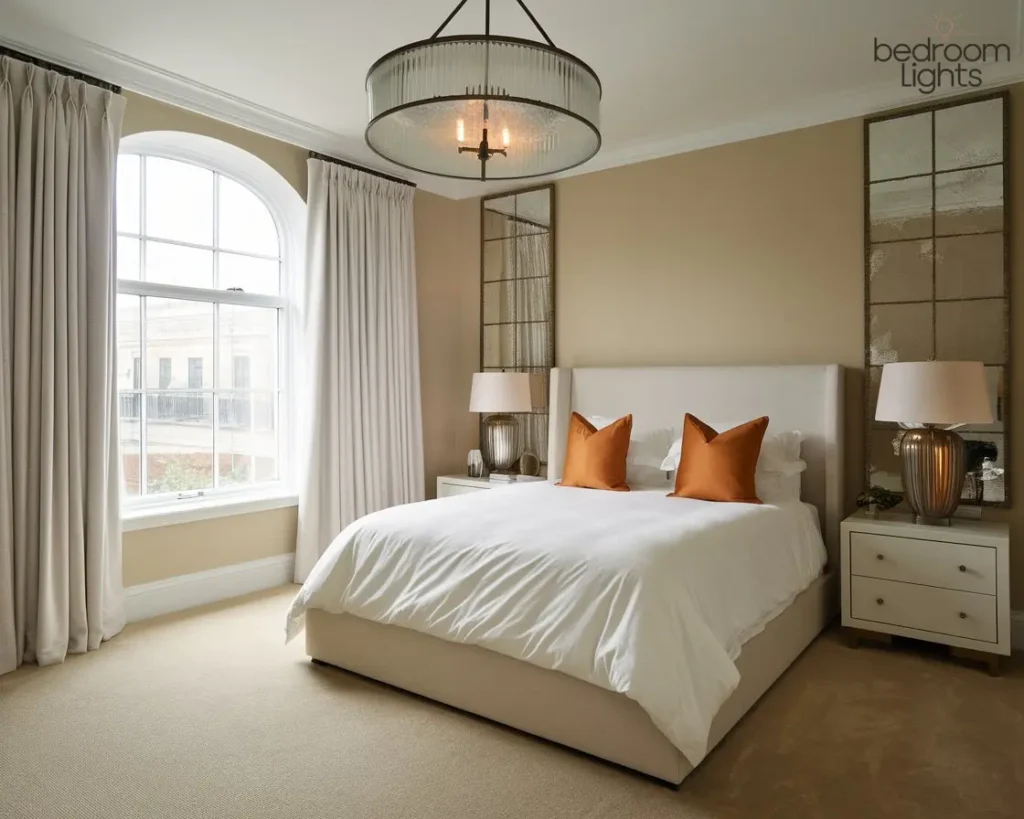
Understanding the Basics of Bedroom Lighting
Creating the perfect lighting setup in your bedroom involves more than just picking out a pretty fixture. To achieve a balanced and functional lighting design, it’s essential to understand the different types of lighting and how they work together.
Here’s a breakdown of the key concepts:
Lighting Layers: Ambient, Task, and Accent Lighting
Ambient Lighting: This is the main source of light in a room, providing general illumination. It’s the foundation of your lighting scheme, ensuring the room is evenly lit.
Common ambient lighting fixtures include ceiling lights, chandeliers, and recessed lighting. The goal is to create a comfortable level of brightness without any harsh shadows.
Task Lighting: This type of lighting is focused on specific areas where activities such as reading, dressing, or working are performed. Task lighting should be bright enough to allow you to see clearly without straining your eyes.
Bedside lamps, desk lamps, and vanity lights are typical examples. Positioning is crucial here; the light should be directed to where it’s needed most.
Accent Lighting: Used to highlight particular features in your room, such as artwork, architectural elements, or decorative objects.
Accent lighting adds depth and dimension, creating visual interest and enhancing the overall ambiance. Wall sconces, track lighting, and LED strips are often used for this purpose.

Color Temperature: Warm vs. Cool Light and Their Effects on Mood
The color temperature of light, measured in Kelvin (K), can significantly impact the atmosphere of your bedroom. It ranges from warm (yellowish) to cool (bluish) tones:
Warm Light (2700K-3000K): This soft, yellowish light is cozy and inviting, ideal for creating a relaxing and intimate environment. It’s perfect for winding down in the evening and preparing for sleep.
Cool Light (3500K-5000K): Cooler, bluish light is more energizing and can help you stay alert. It’s suitable for tasks that require focus, such as reading or getting ready in the morning.
Choosing the right color temperature depends on the mood you want to create and the activities you perform in the bedroom.
A combination of warm and cool lights can offer flexibility, allowing you to adjust the lighting based on the time of day and your needs.

Brightness Levels: How to Choose the Right Brightness for Different Activities
Brightness, measured in lumens, determines how much light a fixture emits. The appropriate brightness level varies depending on the function of the lighting:
General Illumination: For ambient lighting, a moderate brightness level that evenly lights the room is ideal. This can range from 1,500 to 3,000 lumens, depending on the size of the room.
Task Lighting: Needs to be brighter, typically between 2,500 and 5,000 lumens, to ensure clarity and reduce eye strain during activities like reading or dressing.
Accent Lighting: Generally softer, around 500 to 1,000 lumens, to gently highlight specific areas without overpowering the overall lighting scheme.
Using dimmable fixtures or smart lighting systems can provide versatility, allowing you to adjust brightness levels to suit different times of the day and activities.
This flexibility helps create a bedroom environment that is both functional and comfortable.
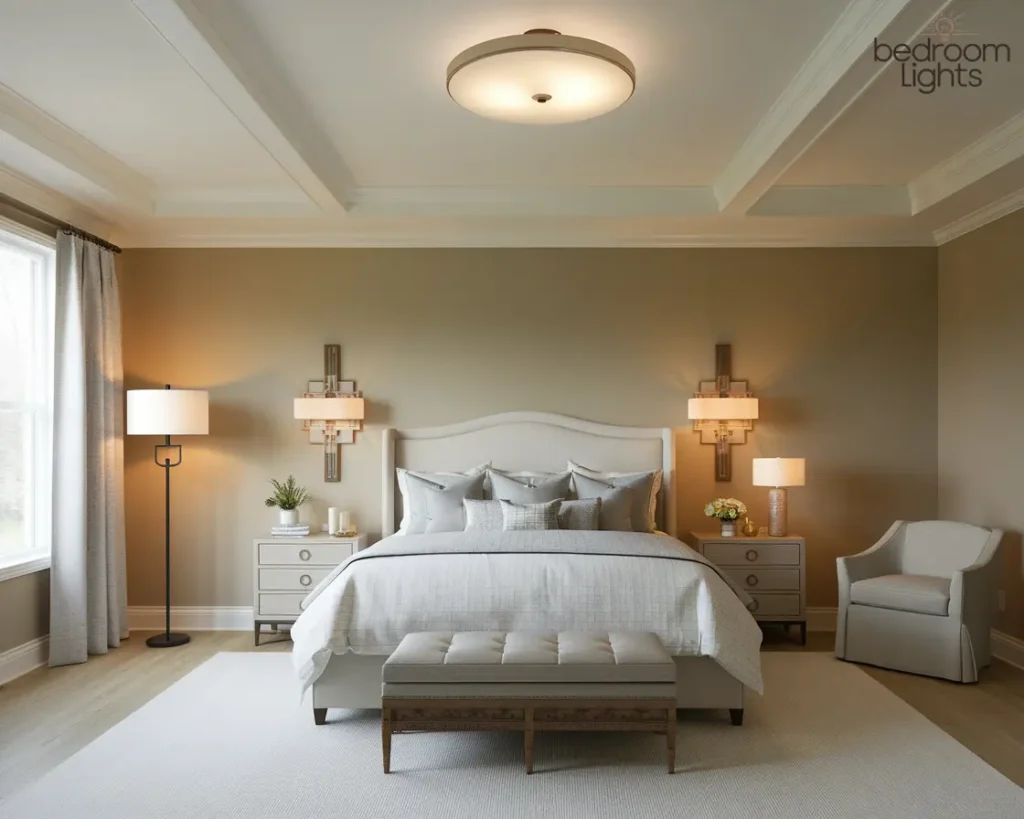
Types of Light Fixtures
Selecting the right light fixtures is crucial for achieving a well-lit and stylish bedroom. Each type of fixture serves a different purpose, from providing overall illumination to highlighting specific areas or features. Here’s a guide to the various types of light fixtures and their uses:
Ceiling Fixtures
Chandeliers: These are decorative, often elaborate ceiling fixtures that serve as a focal point in a room. Chandeliers can range from traditional designs with multiple arms and lights to more modern styles with sleek lines and minimalistic features.
They provide ambient lighting and are ideal for adding a touch of elegance and drama to a bedroom.
Pendant Lights: Hanging from the ceiling, pendant lights offer both style and functionality. They can be used singly or in groups, providing focused lighting for specific areas such as bedside tables or a reading nook.
Pendant lights come in various shapes, sizes, and materials, making them versatile for different design styles.
Flush and Semi-Flush Mounts: These fixtures are mounted close to the ceiling, making them ideal for rooms with lower ceilings. Flush mounts sit directly against the ceiling, while semi-flush mounts extend slightly downward.
Both types offer ample ambient lighting without taking up much space, making them suitable for smaller bedrooms.
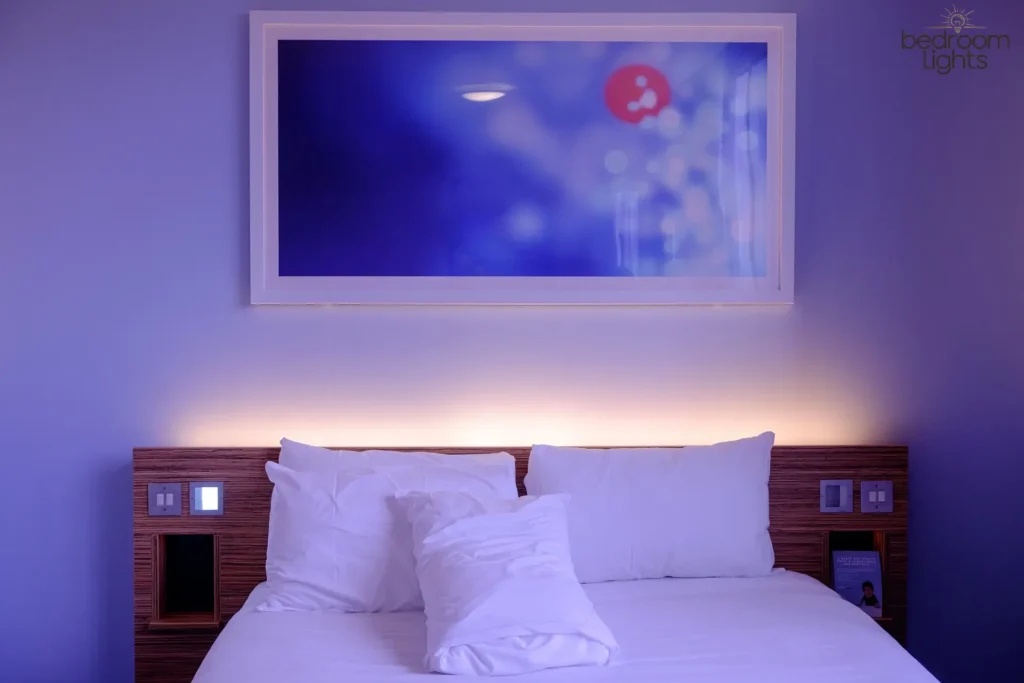
Wall Fixtures
Sconces: Wall sconces are mounted directly on the wall and can provide both ambient and task lighting. They are perfect for flanking a bed, mirror, or artwork, adding a stylish and functional element to the room. Sconces come in various designs, from simple and modern to ornate and classic.
Wall Lamps: Similar to sconces, wall lamps are also attached to the wall but often feature adjustable arms, making them ideal for task lighting. They are particularly useful for reading or as bedside lighting, allowing you to direct the light where it’s needed.
Picture Lights: These are specialized wall fixtures designed to highlight artwork or decorative features. Picture lights help draw attention to specific areas and can add a gallery-like feel to your bedroom.
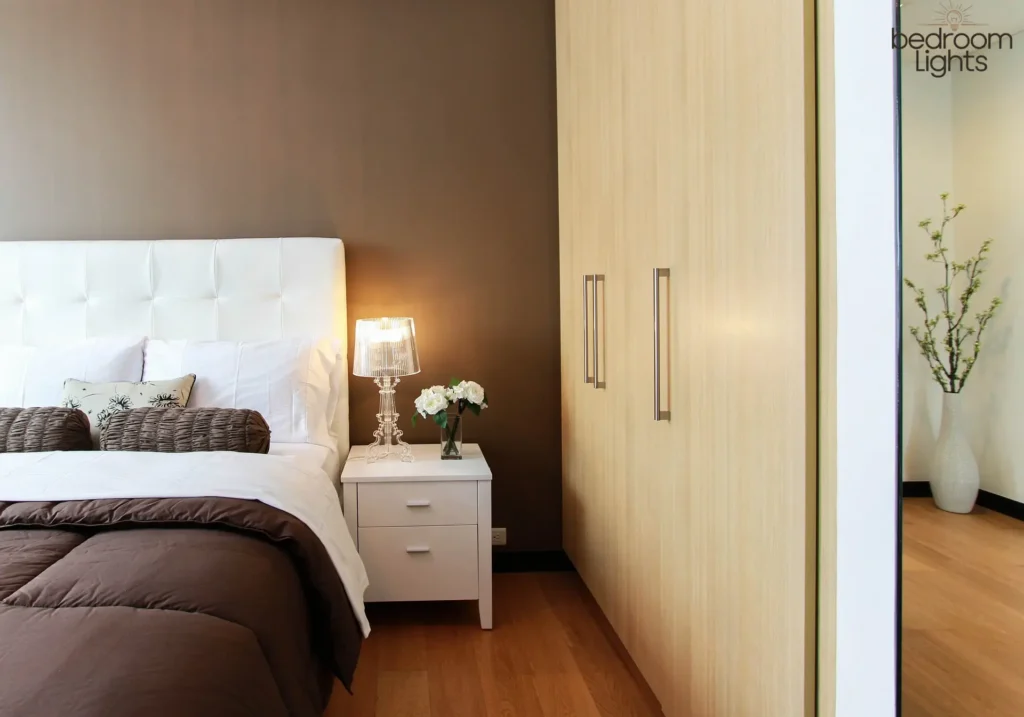
Table and Floor Lamps
Bedside Table Lamps: These lamps are essential for reading in bed or providing soft lighting for winding down in the evening. They come in various styles and sizes, and some feature adjustable brightness levels or USB charging ports for added convenience.
Floor Lamps: Tall and versatile, floor lamps can be used to provide general lighting or to brighten up dark corners. They are available in various styles, from modern arc lamps to classic tripod designs, and can be easily moved to change the lighting arrangement in the room.
Reading Lights: These lamps are designed specifically for focused lighting, making them perfect for reading or other tasks that require a clear view. They can be table or floor lamps and often feature adjustable arms or heads for directing the light.
Recessed Lighting
Downlights: Installed into the ceiling, downlights provide a clean, modern look while offering ambient lighting. They are often used in multiples to ensure even lighting across the room and can be fitted with dimmer switches for adjustable brightness.
Spotlights: Similar to downlights but more focused, spotlights are ideal for highlighting specific areas or features in the room. They can be recessed or surface-mounted and are great for accent lighting.
Track Lighting
Track Lighting: This flexible lighting system features a track with adjustable heads that can be positioned to direct light where needed. Track lighting is versatile, allowing you to change the layout or focus as your needs change. It’s a great option for bedrooms with unique layouts or for those who enjoy rearranging their space.
By understanding the different types of light fixtures and their functions, you can create a layered lighting scheme that enhances the style, comfort, and functionality of your bedroom.

Styles of Light Fixtures
Choosing the right style of light fixture can greatly influence the overall aesthetic of your bedroom. Different styles not only serve functional purposes but also contribute to the room’s character and ambiance. Here’s a guide to various styles of light fixtures:
Modern and Contemporary
Modern and Contemporary light fixtures are characterized by sleek, clean lines and minimalistic designs. These fixtures often feature geometric shapes and are crafted from materials like metal, glass, and acrylic.
They commonly incorporate metallic finishes such as chrome, brushed nickel, or black, which give a polished, sophisticated look. The emphasis is on simplicity and functionality, making these fixtures perfect for a streamlined, uncluttered bedroom aesthetic.
Whether it’s a statement pendant light or understated wall sconces, modern and contemporary fixtures add a touch of elegance and modernity.
Industrial
Industrial light fixtures draw inspiration from factories and warehouses, featuring exposed bulbs, metal finishes, and utilitarian designs. These fixtures often have a raw, unfinished look, with elements like visible pipes, caged designs, and rugged materials such as iron or steel.
The industrial style is all about embracing the beauty of functionality and practicality. It’s perfect for creating a bold, edgy vibe in your bedroom. Industrial fixtures can range from large, dramatic pendant lights to simple, wall-mounted sconces, making them versatile for various room sizes and layouts.
Rustic and Vintage
Rustic and Vintage light fixtures are all about warmth and character. They often feature natural materials like wood, wrought iron, and aged metal, with distressed finishes that give them a weathered, nostalgic feel.
Vintage-inspired fixtures might include elements like Edison bulbs, antique brass finishes, or intricate detailing reminiscent of past eras. This style is perfect for creating a cozy, inviting atmosphere in your bedroom.
Whether you choose a rustic chandelier with wooden accents or a vintage-inspired table lamp, these fixtures add a touch of charm and history to your space.
Traditional and Classic
Traditional and Classic light fixtures are timeless and elegant, often featuring ornate details, curved lines, and rich materials. These fixtures might include chandeliers with crystal accents, sconces with fabric shades, or lamps with carved bases.
The traditional style emphasizes symmetry, balance, and a sense of refinement, making it ideal for creating a luxurious, sophisticated bedroom ambiance.
Classic fixtures are versatile and can complement a wide range of interior designs, from vintage-inspired to more formal, elegant settings.
Bohemian and Eclectic
Bohemian and Eclectic light fixtures are all about creativity and individuality. This style blends different designs, colors, and materials to create a unique, artistic look.
Bohemian fixtures often feature bold colors, intricate patterns, and unusual shapes, incorporating elements like beaded details, woven textures, and vibrant shades. The eclectic style embraces a mix-and-match approach, allowing for a playful and personalized bedroom aesthetic.
Whether it’s a colorful pendant light, a quirky table lamp, or a handcrafted chandelier, Bohemian and eclectic fixtures bring a sense of fun and creativity to your space.
By exploring these various styles of light fixtures, you can find the perfect pieces to reflect your personal taste and enhance the overall design of your bedroom.
Whether you prefer a sleek modern look or a cozy rustic feel, the right lighting can transform your space into a true reflection of your style and personality.
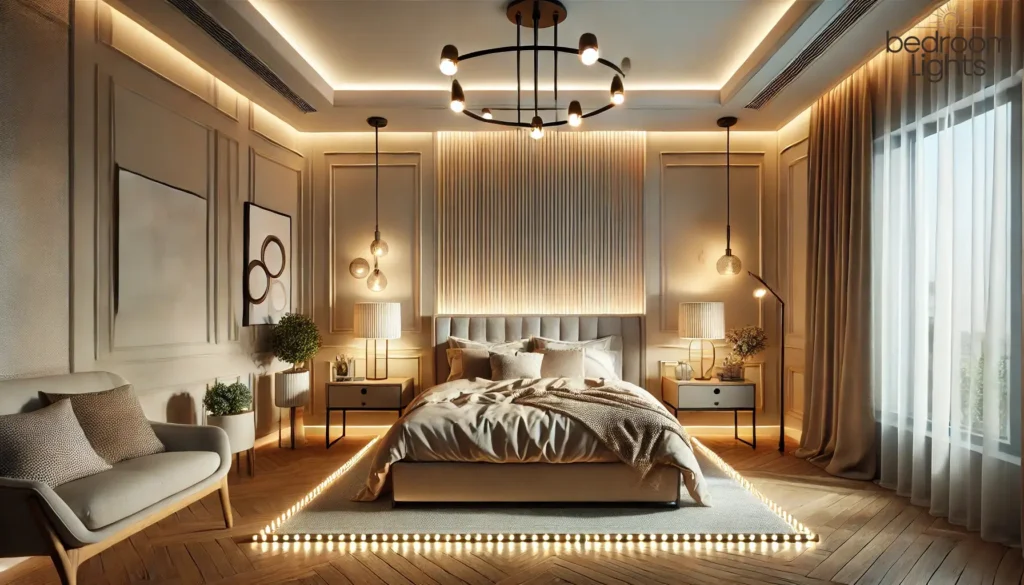
Selecting the Right Light Fixtures for Your Bedroom
Choosing the right light fixtures for your bedroom is essential to create a comfortable, functional, and aesthetically pleasing environment. Here are key considerations to keep in mind when selecting fixtures:
Consider the Size and Layout of the Room
Proportions: The size of your light fixtures should be proportionate to the size of your bedroom. For smaller rooms, opt for compact fixtures that don’t overwhelm the space.
In larger rooms, you can choose more substantial fixtures, like a grand chandelier, that make a statement without looking out of place.
Ceiling Height: The height of your ceiling will influence the type of fixtures you can use. For rooms with low ceilings, consider flush or semi-flush mount fixtures that provide ample lighting without taking up vertical space.
For rooms with higher ceilings, pendant lights or chandeliers can add elegance and draw the eye upward.
Furniture Placement: The arrangement of furniture in your bedroom affects where lighting is needed most. For instance, bedside tables are ideal spots for table lamps or wall-mounted sconces. A reading nook might benefit from a floor lamp, while a vanity area could use focused task lighting.
Matching Fixtures with Interior Design Style
Harmonizing with Colors and Textures: Your light fixtures should complement the color scheme and textures of your bedroom. For instance, a room with soft, neutral tones might benefit from fixtures with warm, metallic finishes like brass or gold.
In contrast, a modern room with sleek, cool colors might be better suited to fixtures with chrome or black finishes.
Overall Décor: Consider the overall style of your bedroom when selecting light fixtures. If your room has a contemporary design, choose fixtures with clean lines and minimalistic features.
For a rustic or vintage room, look for fixtures with natural materials and distressed finishes. The goal is to create a cohesive look where the lighting seamlessly integrates with the rest of the décor.

Functionality vs. Aesthetics
Balancing Form and Function: While aesthetics are important, the functionality of your light fixtures should not be overlooked. Think about the primary activities in your bedroom and select fixtures that meet those needs.
For example, if you enjoy reading in bed, ensure that your bedside lamps provide adequate task lighting. If you want to create a relaxing ambiance, consider dimmable fixtures that allow you to adjust the light intensity.
Versatility and Adaptability: Choose fixtures that can adapt to different situations. Dimmable lights, adjustable arms, and multi-functional fixtures can offer flexibility and make your space more versatile.
For example, a chandelier with dimming capabilities can provide both bright light for getting dressed and soft light for a cozy evening.
Safety Considerations: Ensure that the fixtures you choose are safe for their intended use. This includes checking that they are properly rated for damp or dry areas and that they are installed according to the manufacturer’s guidelines.
By carefully considering the size and layout of your room, harmonizing fixtures with your interior design style, and balancing functionality with aesthetics, you can select light fixtures that not only enhance the beauty of your bedroom but also provide practical lighting solutions for everyday use.
Bedroom Lighting Settings and Tips
Creating the perfect lighting setup in your bedroom involves more than just choosing the right fixtures. It’s about setting up the lights in a way that enhances the ambiance, functionality, and aesthetic appeal of the space. Here are some key settings and tips to consider:
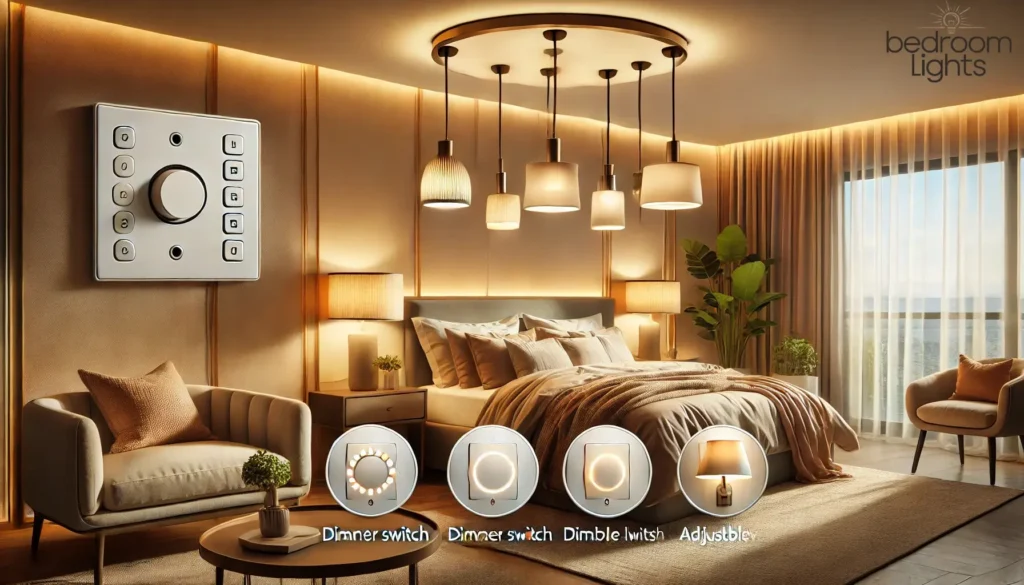
Dimmable Options: Creating Adjustable Ambiance
Dimmable lighting is a versatile feature that allows you to adjust the brightness of your lights according to your needs and mood.
This flexibility is particularly useful in the bedroom, where you might want bright light for activities like reading or getting dressed, but a softer, more subdued light for relaxing or winding down before bed.
Dimmable Fixtures: Many types of fixtures, including ceiling lights, table lamps, and wall sconces, come with dimmable options. When choosing dimmable fixtures, make sure they are compatible with dimmer switches or smart systems.
Dimmer Switches: Installing dimmer switches is a simple way to gain control over your lighting levels. They can be adjusted manually or through a smart system, offering the ability to set the perfect lighting for any situation.
Smart Lighting: Incorporating Smart Bulbs and Systems for Remote Control and Customization
Smart lighting systems allow you to control your bedroom lights remotely using a smartphone, tablet, or voice commands.
These systems offer a range of features, including:
Remote Control: Turn lights on or off, dim them, or change their color temperature from anywhere in your home, or even while you’re away.
Customizable Settings: Create personalized lighting schedules and scenes. For instance, you can set the lights to gradually brighten in the morning to simulate a sunrise or dim in the evening to create a relaxing atmosphere.
Voice Control: Many smart lighting systems are compatible with voice assistants like Amazon Alexa or Google Assistant, allowing for hands-free control.
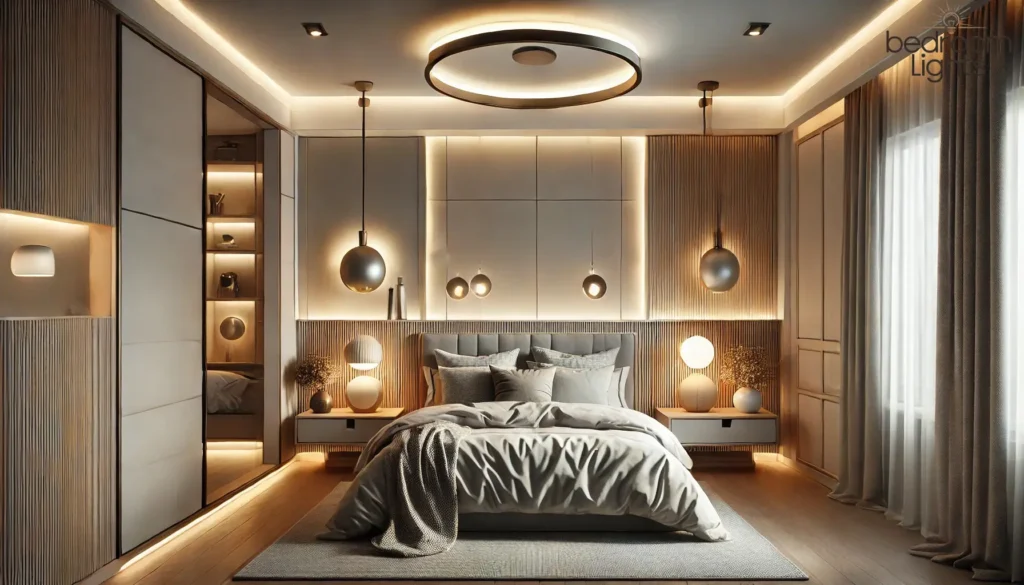
Layering Light Sources: Combining Different Fixtures for a Versatile Lighting Scheme
Layering light sources involves using multiple types of lighting in a room to create a well-rounded and versatile lighting scheme. This approach not only enhances the functionality of the space but also adds depth and dimension to the room’s design.
Ambient Lighting: This is the main source of light and sets the overall illumination level in the room. Examples include ceiling lights, chandeliers, or flush mounts.
Task Lighting: Focused lighting for specific activities, such as reading or applying makeup. Bedside lamps, desk lamps, and vanity lights are typical task lighting fixtures.
Accent Lighting: Used to highlight specific features or create a focal point in the room. Wall sconces, spotlights, and under-cabinet lighting can serve as accent lights.
By combining these layers, you can adjust the lighting in your bedroom to suit different needs and activities, from bright and functional to soft and cozy.
Focal Points and Accents: Highlighting Artwork, Architectural Features, or Specific Areas
Accent lighting is a great way to draw attention to specific features in your bedroom, such as artwork, architectural details, or special decor items. This type of lighting adds visual interest and can enhance the overall aesthetic of the room.
Artwork and Decorative Pieces: Use picture lights or spotlights to illuminate artwork or decorative objects, making them stand out and become a focal point in the room.
Architectural Features: Highlight unique architectural elements, such as alcoves, niches, or textured walls, with directional lighting to create depth and interest.
Specific Areas: Accent lighting can also be used to define specific areas within the bedroom, such as a reading nook or a vanity area, adding both functionality and style.
By incorporating dimmable options, smart lighting, layered light sources, and accent lighting, you can create a dynamic and adaptable bedroom lighting scheme that enhances both the functionality and aesthetic appeal of your space.
Energy Efficiency and Sustainability
Incorporating energy-efficient and sustainable lighting solutions in your bedroom not only helps reduce your environmental footprint but can also lead to significant cost savings over time.
Here are key considerations when choosing energy-efficient lighting options and eco-friendly materials:

LED vs. Incandescent Bulbs: Energy Consumption and Lifespan
LED Bulbs:
Energy Consumption: LED (Light Emitting Diode) bulbs are highly energy-efficient, using up to 80% less energy than traditional incandescent bulbs. This means that for the same amount of light output, LED bulbs require much less electricity, resulting in lower energy bills.
Lifespan: LEDs have a significantly longer lifespan compared to incandescent bulbs. While a typical incandescent bulb lasts about 1,000 hours, LED bulbs can last anywhere from 15,000 to 50,000 hours. This longevity reduces the frequency of replacements, saving both money and resources over time.
Additional Benefits: LEDs are available in a range of color temperatures, allowing you to choose the right lighting ambiance for your bedroom. They also produce less heat, making them safer and more comfortable to use in enclosed spaces.
Incandescent Bulbs:
Energy Consumption: Incandescent bulbs are much less efficient than LEDs, converting only about 10% of the energy they consume into light, with the rest being lost as heat. This inefficiency results in higher energy costs and a larger carbon footprint.
Lifespan: The short lifespan of incandescent bulbs means they need to be replaced more frequently, which can be both costly and environmentally harmful due to increased waste.
Given the clear advantages of LED bulbs in terms of energy efficiency and lifespan, they are the preferred choice for those looking to reduce energy consumption and environmental impact.
Eco-friendly Fixture Materials: Choosing Sustainable Options
When selecting light fixtures, it’s important to consider the materials used in their construction. Choosing eco-friendly and sustainable materials can contribute to a healthier environment and support sustainable practices.
Recycled and Reclaimed Materials:
Light fixtures made from recycled or reclaimed materials, such as metal, glass, or wood, help reduce the demand for new raw materials and minimize waste. For example, reclaimed wood can be used for rustic-style fixtures, while recycled glass can create beautiful, unique designs.
Natural and Renewable Materials:
Fixtures made from natural, renewable resources like bamboo, rattan, or cork are not only eco-friendly but also add a unique and organic touch to your bedroom décor. These materials are biodegradable and have a lower environmental impact compared to synthetic alternatives.
Non-toxic Finishes and Coatings:
Opt for fixtures with non-toxic finishes and coatings to avoid the release of harmful chemicals into your home. Look for products labeled as low-VOC (volatile organic compounds) or water-based, which are safer for both the environment and indoor air quality.
Local and Handcrafted Options:
Supporting local artisans and manufacturers by choosing handcrafted light fixtures can reduce the carbon footprint associated with transportation and promote sustainable, ethical practices.
By prioritizing energy-efficient LED bulbs and eco-friendly fixture materials, you can create a more sustainable and environmentally conscious bedroom lighting scheme. These choices not only benefit the planet but also enhance the aesthetic and functional quality of your living space.
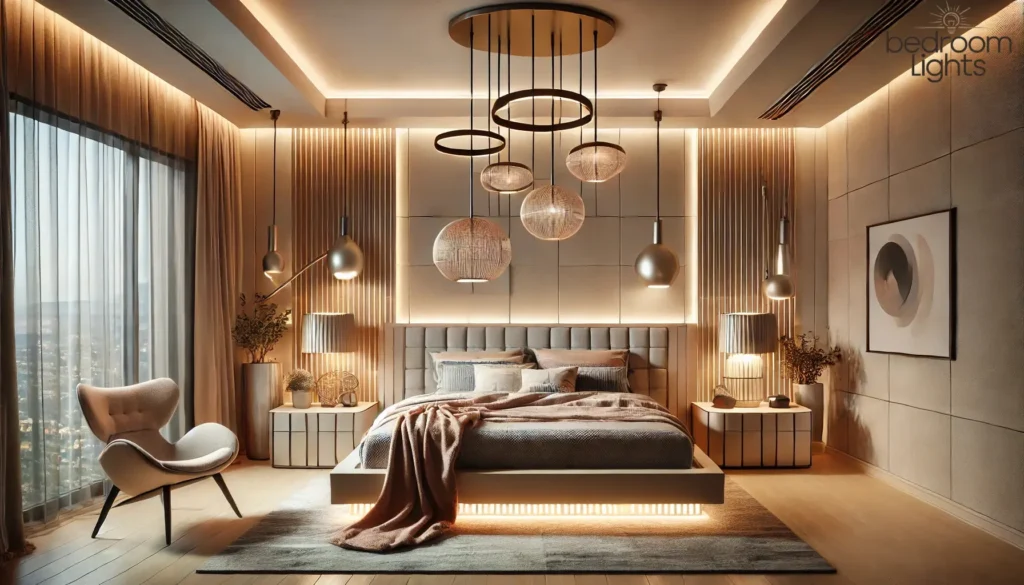
Trends in Bedroom Lighting
Lighting design is an ever-evolving field, with new trends and technologies continually reshaping the way we illuminate our spaces. Staying up-to-date with the latest trends in bedroom lighting can help you create a modern and stylish environment that reflects current design aesthetics and innovations.
Here are some of the current trends and future directions in bedroom lighting:
Current Trends: Latest Design Trends and Innovations
Minimalist and Geometric Designs:
Simplicity and clean lines are at the forefront of modern lighting design. Minimalist fixtures with geometric shapes, such as circles, squares, or linear forms, are popular choices.
These designs often use materials like metal and glass, with finishes in matte black, brass, or chrome, creating a sleek and contemporary look.
Statement Lighting:
Statement pieces, such as oversized pendant lights or bold chandeliers, are being used to create focal points in bedrooms. These fixtures serve as both functional lighting and eye-catching décor elements.
Designs range from artistic and sculptural to vintage-inspired, allowing homeowners to express their personal style.
Natural and Organic Materials:
There is a growing interest in using natural and organic materials in lighting design. Fixtures made from wood, rattan, bamboo, or woven fibers bring a warm, earthy feel to the bedroom. This trend aligns with the broader move towards sustainable and eco-friendly design choices.
Soft and Diffused Lighting:
Soft, diffused lighting is becoming increasingly popular for creating a relaxing and comfortable atmosphere in the bedroom. Fixtures with frosted glass, fabric shades, or built-in diffusers help to soften the light, reducing glare and creating a more soothing environment.
Layered Lighting:
The concept of layered lighting, where multiple light sources are used to create a versatile and dynamic lighting scheme, continues to be a key trend. This includes combining ambient, task, and accent lighting to cater to different needs and moods.

Future Directions: Emerging Technologies and Styles in Lighting Design
Smart Lighting Systems:
The integration of smart technology in lighting is set to become even more prevalent. Smart lighting systems allow for remote control, voice activation, and customization of lighting scenes through mobile apps or smart home devices.
Future developments may include more advanced features such as automated circadian rhythm lighting, which adjusts light color and intensity based on the time of day to support natural sleep patterns.
Human-Centric Lighting (HCL):
HCL is an emerging trend that focuses on the biological and psychological effects of lighting on humans. This approach involves adjusting lighting conditions to support well-being, productivity, and mood.
For bedrooms, this could mean incorporating lighting that mimics natural daylight during the day and transitions to warmer tones in the evening to promote relaxation and better sleep.
Sustainable and Energy-Efficient Innovations:
As sustainability becomes a central concern in design, there will likely be an increase in the use of energy-efficient lighting solutions and eco-friendly materials.
This includes the widespread adoption of LED technology, the use of recycled or sustainably sourced materials, and fixtures designed for longevity and durability.
Adaptive and Personalized Lighting:
The future of lighting design may see more personalized and adaptive solutions, where lighting systems learn user preferences and adjust automatically.
This could involve sensors that detect occupancy and adjust lighting accordingly, or systems that sync with other smart devices for a fully integrated home environment.
Mixed-Material and Eclectic Designs:
Mixing different materials and styles in lighting fixtures is expected to grow as a trend, offering a more eclectic and personalized aesthetic.
This could involve combining metals with natural elements, using unconventional materials, or integrating technology in unexpected ways.
By keeping an eye on these trends and emerging technologies, you can stay ahead in creating a bedroom lighting scheme that is both stylish and functional, meeting the needs of today while preparing for the innovations of tomorrow.
Choosing the right light fixtures for your bedroom is a crucial aspect of interior design, as it impacts both the functionality and ambiance of your space.
Stylish and functional lighting not only provides necessary illumination for daily activities but also sets the mood and enhances the overall aesthetic of your room.
From understanding the basics of lighting layers and the effects of color temperature to selecting fixtures that match your design style and considering energy efficiency, every detail contributes to creating a comfortable and inviting environment.
The world of bedroom lighting offers endless possibilities, from minimalist and modern designs to rustic and vintage styles. By layering different types of lighting—ambient, task, and accent—you can create a versatile and adaptable lighting scheme that caters to various needs and activities.
Additionally, incorporating smart lighting technologies and sustainable practices can further enhance the functionality and environmental friendliness of your space.
Ultimately, the choice of lighting fixtures is a personal one. It’s an opportunity to express your style, creativity, and individuality. Whether you’re drawn to bold statement pieces or prefer subtle, diffused lighting, the key is to explore and experiment with different options.
Personalize your lighting choices to create a space that not only looks beautiful but also feels right for you. With thoughtful selection and planning, your bedroom can become a haven of comfort, style, and tranquility, perfectly illuminated to suit your unique taste and lifestyle
